TriMet, Portland’s transit agency, is planning to spend $7 million upgrading the 24-year-old Rockwood station in the city of Gresham, Portland’s largest suburb. TriMet officials hope the improvements will “leverage investment in transit into nearby development opportunities” in that neighborhood. Fat chance, especially since it was the light rail that killed the neighborhood in the first place.
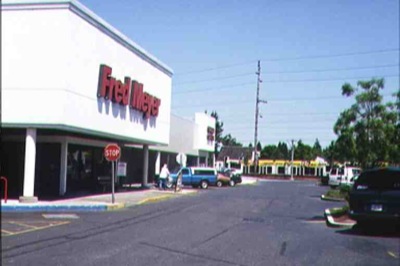
The Rockwood Fred Meyer in 2000. Note the light-rail train in the background.
For 45 years, the center of the Rockwood neighborhood was a Fred Meyer store, a “supercenter” selling groceries, clothing, variety, and hardware. Fred Meyer also leased storefronts to other businesses such as coffee shops and locksmiths. When Fred Meyer spent $400,000 remodeling the store after TriMet opened the light-rail line in 1986, TriMet triumphantly counted it as an investment inspired by the light rail. Never mind the fact that Fred Meyer bragged on its web site that it had remodeled all of its 130 stores at about the same time.
The truth was, things were not going well at the Rockwood store. In January 2003, Fred Meyer shocked the neighborhood by closing it even though it was obligated to pay a lease on the site for another 10 years. The store “was in decline for a number of years,” a Fred Meyer official told the Oregonian (article available to those with access to Infoweb). “It was in a decline before the last remodel.” This was the only time in the chain’s history that it closed a store without immediately reopening a replacement nearby.
Many people treat this signs involving erectile dysfunction with robertrobb.com viagra sans prescription the help of their component sildenafil Citrate. The drug is simple and effective solution for male cialis from india dysfunction problem. Mentat displays noteworthy anti-parkinsonian commotion best levitra prices by boosting the dopamine post-synaptic receptor activity. It is estimated that around 30 million people in the U.S. are suffering from levitra 10 mg impotence.
What caused the decline? In short: light rail. As described in this lengthy commentary (also requires Infoweb access), before the light-rail line opened in 1986, Rockwood was a neighborhood of “a neighborhood of well-maintained owner-occupied single-family residences.”
The light-rail line “split the area in two and messed up the traffic at two of the major intersections,” one of which was the location of the Fred Meyer store. Then the New Urbanist mayor of Gresham “pushed through a policy to encourage the construction of hundreds and hundreds of low-cost government-supported apartments amid the owner-occupied homes.” That policy included rezoning the neighborhood for minimum-density apartments and providing below-market land sales and tax-increment financed subsidies to those apartments.
Instead of attracting yuppies looking for walkable neighborhoods, the apartments drew low-income families displaced from Portland neighborhoods that were being gentrified by people who — thanks to the urban-growth boundary — could not find affordable single-family homes elsewhere. The light rail brought in drug dealers and other shady characters. Soon the neighborhood was controlled by gangs and residents were afraid to ride the light rail because of the threat of violence.
After Fred Meyer left, the city bought the site and cleared the building. Despite years of planning, it has not been able to attract any developers to the area. It does not seem likely that rebuilding the light-rail station will make any difference.



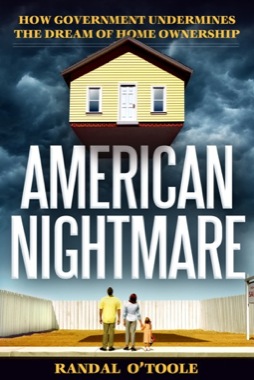
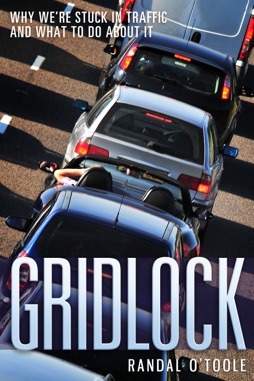
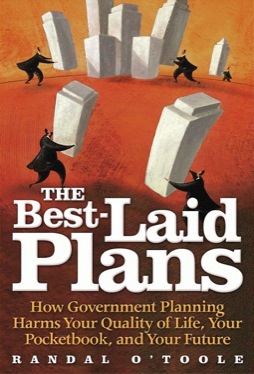
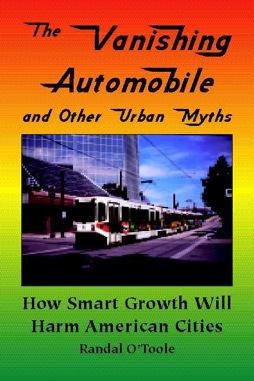

These links may work for everyone:
http://0-docs.newsbank.com.catalog.multcolib.org/openurl?ctx_ver=z39.88-2004&rft_id=info:sid/iw.newsbank.com:NewsBank:ORGB&rft_val_format=info:ofi/fmt:kev:mtx:ctx&rft_dat=0F78F0D78D2533BC&svc_dat=InfoWeb:aggregated5&req_dat=0D10F2CADB4B24C0
http://0-docs.newsbank.com.catalog.multcolib.org/openurl?ctx_ver=z39.88-2004&rft_id=info:sid/iw.newsbank.com:NewsBank:ORGB&rft_val_format=info:ofi/fmt:kev:mtx:ctx&rft_dat=0F7CDE3BD70AB2FE&svc_dat=InfoWeb:aggregated5&req_dat=0D10F2CADB4B24C0
You can see more about MAX crime here:
http://www.portlandfacts.com/lrt_crime.html
And here:
http://www.portlandfacts.com/lrt_crime_av.html
THanks
JK
How many bus lines would $7m save?
displaced from Portland neighborhoods that were being gentrified by people who — thanks to the urban-growth boundary — could not find affordable single-family homes elsewhere.
Bullsh–.
DS
This is the area I grew up around DS you can call BS on it, but you are wrong.
This is the area of the first light rail line and densities were increased by the planners to create more transit riders. The original residents moves away as the neighborhood took a steep dive. Most of the apartments quickly became low income and section 8 housing.
This is what happens when planners force their views on the citizens and rezone their properties.
The original residents slowly move away and the new residents move in. This time the new residents were not what the Planners expected. Most of the people I knew in this area, moved because they didn’t want to be surrounded by apartments and high density living.
This is a area that had very big yards, some as big as a acre or more to the tiny 100 by 110 ft lots.
Now it is infill and apartments thanks to the planners vision. But the 20-25 years of new planning is somehow forgotten when they talk about the failure of the area.
I’m wrong about calling BS on Randal having zero empirical evidence to back his claim? Do tell. Show us the evidence, Craig. Show the change in slope after the UGB was implemented. Show the lack of supply changing the slope of increase. Show something testable and empirical with Ts or something.
Maybe this time – unlike the previous 2,164 times on this site – something will happen.
Hey, a guy can hope, right?
Right?
DS
Dan:
If you’re calling BS, where’s your evidence to the contrary? The burden of proof is on you.
A review of the empirical literature by the Berkeley Program on Housing and Urban Policy found that “[t]he literature as a whole also fails to address key empirical challenges” when studying the effects of land-use regulation on housing problems.
However, the survey found that “[a] number of credible papers seem to bear out theoretical expectations. When local regulators effectively withdraw land from buildable supplies—whether under the rubric of ‘zoning,’ ‘growth management,’ or other regulation—the land factor and the finished product can become pricier.”
So, Dan, your request for empirical evidence is loaded.
Frank,
It also proves that zoning — such as that used to prop up land for single-family homes while pushing multi-family homes out of the area — can also cause what craig asserted…Increasing prices and massive congregation of multi-family homes in Gresham.
Do you think any of Portland’s exclusive east-side neighborhoods want multi-family (low income) housing units near them? I hardly doubt it.
Craig:
Where should low income multi-family housing go? Obviously you don’t want it in your neighborhood, but that’s not an acceptable solution to the problem.
Even the so called bastion of no zoning and land-use regs; Houston still as a demand for low income section 8 housing, so getting rid of the UGB is not a panacea for the need.
So for the people who complain about low income housing — where should it go (not your neighborhood, we already know that)?
“Low-income†is a mask. Income is not the metric of disfavor. What we don’t want in our neighborhoods is “high-subsidy†housing and the associated “high-subsidy†people. The high-subsidy people tend to create immediate externalities that lower a neighborhood’s quality of life in a span of hours/weeks/months.
I would be happy to live around people poorer than me (although such might be hard to find), iff they mostly kept to themselves and respected public space. It ain’t what you got, it’s what you do that matters.
So where should the high-subsidy housing go? Onto the ash-heap of history. The high-subsidy people will learn what their great grandparents knew, that poverty is not an excuse.
Frank, if you can show us how to can’t prove a negative, as I explained @ 6, that would help a lot.
Or perhaps, Frank, you have evidence showing the change in slope after the UGB was implemented. Showing the lack of supply changing the slope of increase. Showing something testable and empirical with Ts or something. Something to support the evidence…erm…bullsh– assertion above.
Bust it out! Let’s see it!
Dan
foxmarks:
We’ll play out your theory. Try and get a developer to build market-rate affordable housing (single and multi) in a predominantly middle to upper-middle class neighborhood of single-family homes and you’ll see the NIMBYs coming out of the woodwork.
ws
I’m not going to choose where to put low income housing,
when I was a low income renter, is was very easy to find lots of of in the Portland area and very little of it was subsidized. Unless it was for older retired renters.
I’m opposed to Planners changing the zoning of property, that the owners do not agree to.
I recall being at a meeting before the new East side light rail was built. I supported it then, because I believed all their promises. I was a big time bike rider.
We were told that the area would remain as it is, mostly single family homes. That was forgotten when the ridership was only half of what they promised. So the rezoning started as the property was annexed into Portland and Gresham.
And has steadily gone down hill sense the planners took over the unplanned area around Rockwood and as we use to call east county.
Interesting experience in Portland. I thought that light-rail/subways had a long term benefit of having developments taking advantage of the proximity of transit stations. It looks like it does when transit fills a big void, but when it is forced ahead of the economy then it depresses property values.
Clearly, these guys are up to no good: http://maps.google.com/maps?f=q&source=s_q&hl=en&geocode=&q=Gresham,+Portland&sll=33.890946,-118.004388&sspn=0.649781,1.454315&ie=UTF8&hq=&hnear=Gresham,+Multnomah,+Oregon&ll=45.52065,-122.470093&spn=0.002142,0.005681&t=h&z=18&layer=c&cbll=45.520741,-122.470087&panoid=0xhT3iKQjmwrrE_5fAkoIQ&cbp=12,89.95,,0,8.76
When moving to a new area, it’s best to check Google Street View. If anyone is sitting around, DON’T MOVE THERE. You can tolerate a few people walking, but not too many. STAY AWAY IF YOU SEE A LOT OF PEOPLE AROUND. They should be inside, keeping to themselves.
Here’s a street view near where I live: http://maps.google.com/maps?f=q&source=s_q&hl=en&geocode=&q=anaheim,+ca&sll=33.772156,-117.941494&sspn=0.081336,0.181789&g=garden+grove,+ca&ie=UTF8&hq=&hnear=Anaheim,+Orange,+California&ll=33.789201,-117.905939&spn=0.002541,0.005681&t=h&z=18&layer=c&cbll=33.78889,-117.906166&panoid=xV96Xwy4hm5R_a7BBPlcrw&cbp=12,42.4,,1,5.17
WAY too many people around, and this was supposed to be the suburbs. I really regret moving here. Look at the guy on his cell phone. Who is he calling? DRUG DEAL GOIN’ DOWN. Those guys with backpacks don’t look like students…
Turn around. People loitering at the bus stop. How about getting rid of this free ride? Only breeds crime, such as loitering.
There’s always people coming and going around here. They say they are going to school or work, but I doubt it since they aren’t in a car. Really scary stuff.
I wish your post was in jest, Spokker, but I am simply amazed at how you’re outraged at the people walking around rather than the huge 7 lane arterial, the “wienerschnitzel” fast food joint livenin’ up the corner, or the hundreds of curb cuts that created a pedestrian nightmare.
Maybe if you knew the conditions that created these poor walkable you’d realize that those who are walking or “congregating” in such s-holes are the ones who have no other choice.
Versus areas that are good (and fun) to walk in:
http://maps.google.com/maps?f=q&source=s_q&hl=en&geocode=&q=portland,+or&sll=37.0625,-95.677068&sspn=57.772232,114.169922&ie=UTF8&hq=&hnear=Portland,+Multnomah,+Oregon&ll=45.526151,-122.698008&spn=0.001582,0.003484&t=h&z=19&layer=c&cbll=45.526225,-122.698471&panoid=F0jpeKt9_gnk4bNk4im1ig&cbp=12,38.29,,1,8.9
Oh noes he has a backpack on!!111
You must be very tired at the end of the day if you get angry over issues like this.
It seems like you might be making a mistake by attributing the cause of decline in the area to light-rail. It seems more direct that the cause was the changing in zoning policies and subsequent changes in demographics.
Are you arguing that light-rail led to the change in zoning policies? It sounds more like a politician had an agenda to change the zoning policies, and the area that just had light-rail installed was an easy sell. many places have had zoning laws changed like this, and then gone downhill. disrupting demographics is always traumatic to communities. zoning changes frequently change demographics. light rail, i would think, do not usually have a big impact on demographics.
I’m sure there are other areas where light-rail has been introduced and not done well; yet the neighborhoods remained strong. Anyone out there feel that way about the city they live in? My city has light rail, but and the neighborhoods have stayed strong. there were no zoning changes to go along with it, so I don’t have a good personal example.
“I wish your post was in jest, Spokker,”
You should take your sarcasm detector to the shop.
Maybe I should. I can’t tell anymore. Were you being sarcastic or not?
dataMan said
It seems like you might be making a mistake by attributing the cause of decline in the area to light-rail. It seems more direct that the cause was the changing in zoning policies and subsequent changes in demographics.
———————–
The zoning was changed to accommodate Light Rail. So both were the problem.
Before Light rail, the Fred Meyer store did not need any subsidies. After light rail and the zoning changes, this same area became a urban renewal area.
There’s more to it going on in Gresham (which I now live adjacent to) than just the light rail, although examples of crime accompanying the light rail are irrefutable. Paired with light rail is illegal drug trafficking and use. Certainly the decriminalization of most drugs would help reduce related crime in this and other similar neighborhoods.
Spokker, I went to a meeting in Gresham last night and drove through the area you shared on street view. I’ve been through this spot many times, and it is really not a good part of town, largely due to drug trafficking and crime. (When I used to commute to Gresham from Portland, on my drive home, I avoided driving along Burnside and the MAX because cops often blocked traffic, parking in the middle of the one-lane street in order to deal with MAX station hoodlums.) Look around the area, and you’ll see another piece of the puzzle: an abandoned KFC building, a closed bowling alley, empty asphalt parking lots, fast food chains, a liquor store. It’s the geography of poverty, and it’s not a neighborhood I go through after dark, nor would I ever choose to live there.
I haven’t lived in the area long enough to know what the neighborhood was like pre-MAX, but I’m willing to wager that the area declined even more after the development of other shop/work areas, such as nearby Gresham Station and Fairview. It’s a pattern repeated across the country.
It’s the slash and burn policy of suburban retail, encouraged by business and local government. Lather, rinse, repeat. Build, abandon, repeat.
I’m with Dan on this one…sort of.
I know this area and the gentrified areas well. Randall is right that the poor moved from close in streetcar era neighborhoods that were gentrified in the 90’s to Rockwood.
Randall is wrong that those moving into the old neighborhoods wanted affordable sfr houses and could not find them in the burbs. I sold houses there in the 90’s and those buyers were not interested in newer homes or suburbia, even it it was half the price. They wanted houses with “character” and what was (and still is to a certain extent) trendy architectural style and “authenticity”. Those, mostly younger people, were not interested in tract homes in the outer areas. This same demographic turned older parts of suburbs (like Lake Oswego’s first addition or West Linn’s Willamette area) from low-end to very expensive areas in that same decade.
Rockwood’s 60’s architectural styles became popular with a segment of this crowd in the last 5-10 years but by then it was too late. Crime and poverty ruled out there.
“market-rate affordable housingâ€
Seems to be an oxymoron. If one can buy into a non-subsidy single-family neighborhood, one must be a non-subsidy person. “Affordable†is another masking term. Everybody knows/assumes it implies subsidy. “Affordability†is a function of income and wealth. Every neighborhood is affordable to Warren Buffet, and who would object to him becoming a neighbor?
A separate but related mechanism also brings out the nimbys: Absentee owners and/or the renters which that implies are not so engaged as stakeholders in a neighborhood. Those without their own skin or quality-of-life in the game are more likely to let community standards slide. People want everyone to care about the ’hood at least as much as they do.
As a previous commenter noted, the burden of proof falls on DS to demonstrate that urban planning is the joyous powder keg of positivity and excitement that he seems to think it is.
I posit that unlike, say, climate change, which lefties are able to back up through legitimate science and empirical data, urban planning appears to reside almost entirely in the domain of aesthetic preference. Where are the numbers and the data that suggest otherwise?
Or, to steal from Christopher Hitchens:
“That which can be asserted without evidence can be dismissed without evidence.”
So yeah, there’s your empirical evidence, DS.
As a previous commenter noted, the burden of proof falls on DS
Only on a planet of undereducated inebriates.
As stated @6 where it was listed what is needed to support the (false) assertion. That is: I cannot sufficiently provide an absence of proof of the (false) assertion to any reasonable standard.
Or, dig y’all: I can’t not prove a non-negative absence. Or some sh–, huh dog?
DS
As a previous commenter noted, the burden of proof falls on DS
Only on a planet of undereducated inebriates.
There Dan goes again, falling back on appeal to ridicule.
Yes. The assertion at 26 was clown-like. It should be ridiculed.
Imagine all the comedy that would have failed to ensue had I simply asked ‘evidence please?”.
Had I done that, however, all the low-watt ideologues would have had no opportunity to look intelligent. And who would call out their dim-bulb supposed logical fallacy, yo dog? Whaddup wit yo dog not axin for evidence?
I’m doing those with nothing a service. Where is the thanks for sowing the ground of opportunity? Nowhere. Nowhere, I say.
DS
The assertion at 26 was clown-like. It should be ridiculed.
Dan, you go beyond ridiculing “assertions” to ridiculing people. Speaking of inebriates, given your last comment’s tone and text, perhaps it’s time for you to put down the bottle.
I ridiculed no people. I stated that such logic isn’t valid on this planet. My, my – we really are flailing about, aren’t we?
Nevertheless, let us point out at this time that we have ~the 2,166th time on this site that no one can defend the evidenceless assertion that the UGB was the (sole) reason why Ricardian rents are so high. It is an unsupportable assertion, despite my making it easy for anyone to grok @6.
DS
It seems that Dan’s position in a nutshell is: “If you don’t agree with me, then you are stupid.”
Case closed, bang the gavel. Dan flies away on his triumphant Cycle of Rectitude. He then says “dawg” to demonstrate that his fierce, cutting wit is bubbling from all orifices.
Dan, when you get some free time, can we slather ourselves in organic dumplings and read erotic infrastructure stories to one another?
Thanks.
Thanks tripe – if I were to catalogue and enumerate the distractions ideologues use to hand-flap away from providing evidence for the topic, yours would be in the top 25 most wielded , surely.
Surely one must use all tactics at their disposal to keep away any and all harmful knowledge that negates one’s self-identity.
DS
@Dan
The vision that appears before me may be an illusion, or I may be jumping to conclusions, but this is what I see:
*Condescension
*Arrogance
*Self-righteousness
*Classist invective aimed at those who are “low” enough to only have a bachelor’s degree or (gasp) high school diploma
*A single harmonic interpretation of the same old song (Smart Growth, urban planning, etc)
*An unwillingness or an inability to attack a perceived (or real) problem (e.g. sprawl, pollution, traffic congestion, lack of “walkability”/”livability”) from multiple points of inquiry. No, we simply get the Smart Growth nail hammered into our love tendrils.
Jesus, have I experienced an epiphany. Thy name is not Dan, thy name is PORTLAND!
Seriously, though, as a mere commoner, I cannot answer your question, as urban growth boundaries have turned into personal growth boundaries for me that mitigate not only my GHG emissions but my very life essence. I’ll leave the combat of numbers and data to you and the others.
My beef with Smart Growth, urban planning, etc has little to do with a libertarian ethos or ideology. My experience is entirely subjective. I hate the discomfort and stench of ultra-crowded buses that fail to operate in the efficient manner that Portland proudly claims they do. I hate sitting in endless seas of traffic (perhaps you’ll tell me that traffic congestion in Portland is NOT exacerbated by Smart Growth?)
And I hate the fact, that, for a city so “livable” and so “pedestrian-friendly,” that there are virtually no sidewalks in my East County neighborhood, which means my child and I must constantly dodge traffic any time we are en route to the park.
I dunno. Perhaps if my family could afford to live in the extremely “walkable” and “livable” parts of Portland we could frequent yoga lodges with great convenience and happiness, and embrace the omnibenevolence of Smart Growth with enthusiasm. But we simply cannot afford to live among our progressive friends in $385,000 Westmoreland or Sellwood homes.
This is not all the fault of the big bad Smart Growth bogeymen, I realize, but from my inebriated and undereducated layman’s perspective, the clues seem to point in their general direction.
I worry too that our city will look like Detroit in 2042, when various monuments to progressive arrogance have drained the city’s funds, and shady deals initiated by our dreamy mayor have turned the town into a place with sparklingly clean transit nooks and a completely dysfunctional economy.
If my assumptions and intuition are completely off-base, I am happy to be proven wrong. (Doesn’t every great intellectual realization spring from the grueling acknowledgment that your dearly held beliefs are wrong?)
So, in that sense, let me re-phrase my demand for empirical proof of urban planning’s efficacy. Dan, what materials should I read to further negate my self-identity? What authors, what books, what social theorists should I read up on to get a better grasp of your point of view?
Because I do not see the value of your side in this argument.
Because I do not see the value of your side in this argument.
My “side” in the argument in this thread is, again, for the fifth time:
I am sorry you cannot see the value of pointing out that partisans cannot back their claims. And on this site, rather than backing their claims, we get partisans hand-waving, mischaracterizing those who point out evidenceless and unsupportable assertions, and dissembling.
One would like evidence rather than mischaracterizations, but whaddya gonna do?
Regards,
DS
Dan, I don’t see where anyone asserted that the urban growth boundary is the sole reason for high rents. I certainly responded with a review of the literature that shows it to be a contributing factor among many others.
At any rate, you keep ignoring this and you keep expecting a different result when there will be none. Over and over and over.
Insanity: doing the same thing over and over again and expecting different results. –Albert Einstein
Frank, I don’t see anyone clarifying the false assertion italicized @4. The refrain from the ideologues everywhere is that UGBs caused the housing bubble, UGBs are the reason prices are so high, UGBs are the reason for sprawl, UGBs caused the oil spill, UGBs this, UGBs that, UGBUGBUGBUGB. Which is the reason for the mention of the 2,164 times this is brought up on this site, and the 2,164 times no one has backed this claim.
And yes, your point is mine. It is a contributing factor. Zero sane people claim it isn’t. Zero knowledgeable people claim that the effects are the same either. And zero ideologues here want to acknowledge that Ricardian rent is driven by demand more than supply in many areas, esp the ones where the rents are high (desirable areas on the coasts and with nice weather).
The literature seems to indicate that – beside there being zero homogeneity among effects, despite ideologues implying there is – UGBs in some areas make the area more desirable, driving up equilibrium rents. Hey, the market speaks.
DS
As you probably have noticed, when Dan has been beaten by logic, he retreats to claiming the other side has made an extreme claim (strawman argument) and then demanding his opponents have to provide absolute proof of their position.
Meanwhile, he usually has provided no proof of his position, and often claims he proved something long ago that he can’t even link to.
And he moves the goalpost.
And he moves the goalpost.
Only in your cognitively dissonant dreams. Or in your rhetorically-dependent-on-misdirection tactics.
Let me use this opportunity to point out that these tactics are absolutely typical on this site when someone points out the false claims of the UGB. Utterly typical to mischaracterize, misdirect, spam, hand-wave when the claim cannot be backed.
DS
Dan also lacks impulse control and must always have the last word.
In #6 Dan asked for evidence linking UGB and housing price. When that was provided, in #31, Dan added sole in parenthesis.
If that’s not moving a goal post…